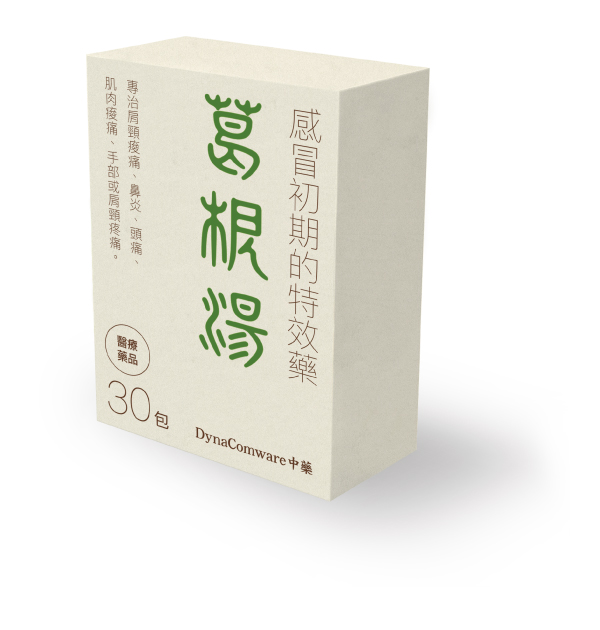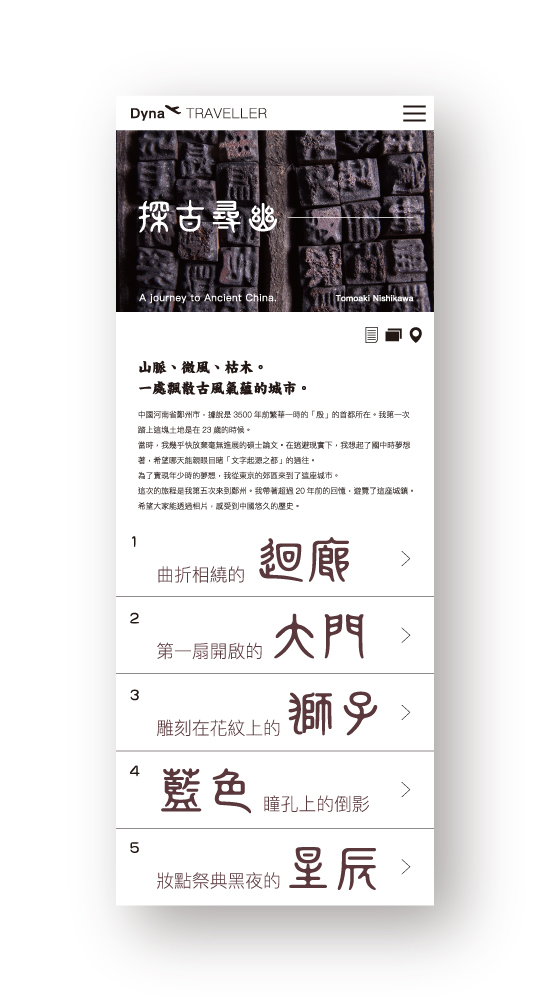Category:Font Design Concept
2020/07/31
DynaFont Calligraphy Font - DF Bronze Inscription
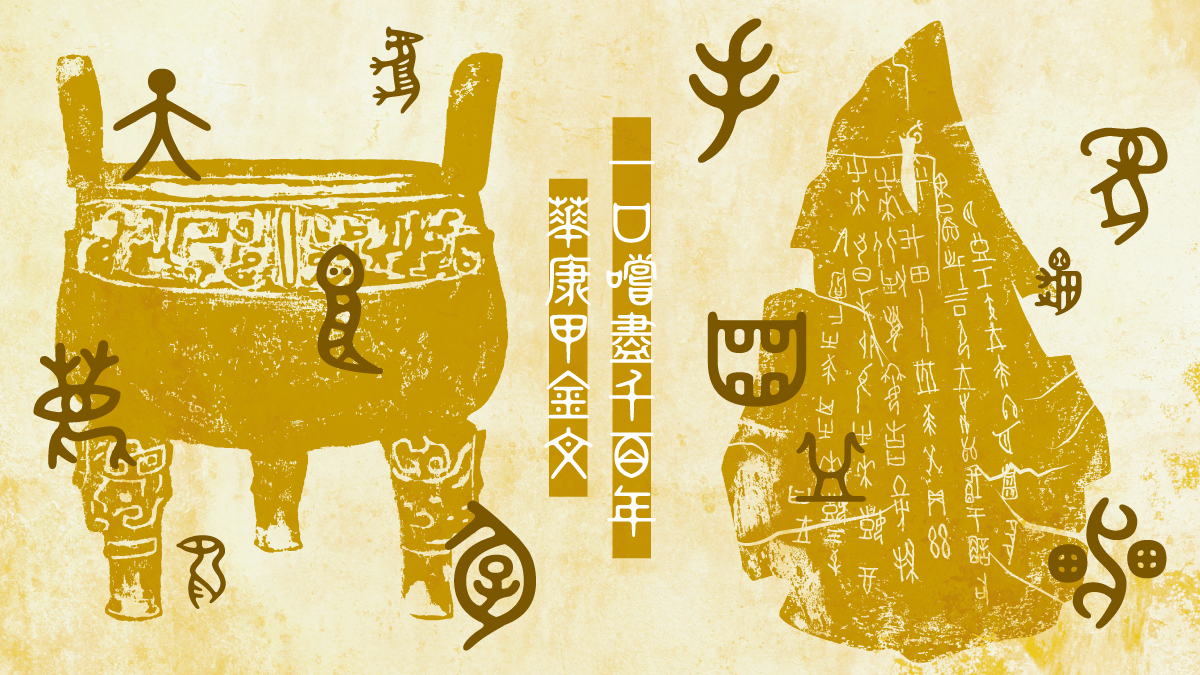
一口嚐盡千百年
A millennia of history condensed into one single typeface
A millennia of history condensed into one single typeface
Chinese characters originate from pictograms - they take inspiration from elements in our environment, which is why ancient characters were more graphic in nature. Just as we did while creating DF JinWen font, DynaComware returned to the structural aesthetics of ancient characters, adopting the features of nature and geometric images from oracle bone script and ancient bronze inscription from the pre - Qin dynastic period to develop a simple but elegant font - the DF Bronze Inscription.
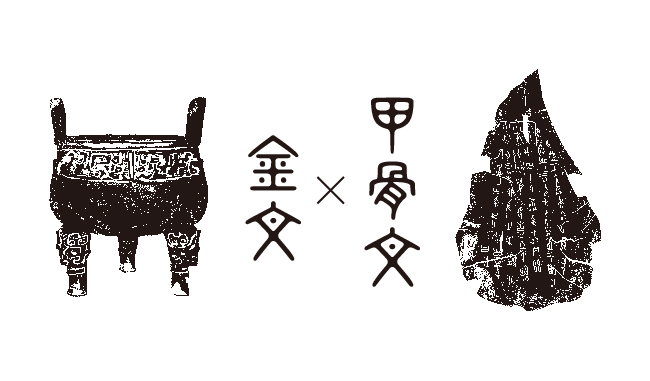
Reinvigorating an antiquated style, while integrating ancient characters into a digital lifestyle
DF Bronze Inscription is a font developed in the style of ancient characters that can be directly applied to typesetting. It not only retains the features of oracle bone script and bronze inscription from the Shang and Zhou dynasties, but is an innovative solution to difficulties encountered in the development of ancient character fonts.
DynaComware made a breakthrough in giving ancient characters from the pre-Qin period good recognizability, which had long been a persistent challenge in font design. The Da Yu bronze vessel bronze inscriptions from the Western Zhou dynasty - and bronze inscriptions and oracle bone script collected in the National Palace Museum and Institute of History and Philology (Academia Sinica in Taiwan) - have been reinterpreted via font design. They have now become characters that everyone can easily recognize. The graphic liveliness of pictograms is preserved, giving readers a glimpse of history by reinvigorating the evolution of the ancient characters, and then integrating them into today's digital lifestyles.
During the development process, oracle bone script - one of the ancient character inspirations of DF Bronze Inscription - was selected into UNESCO's Memory of the World Register. This made our in-house design team even more determined to reinvigorate this ancient form of written text. Through DF Bronze Inscription, the team hoped to introduce ancient characters collected in museums directly into our modern life, so that they can be easily passed down and remembered.
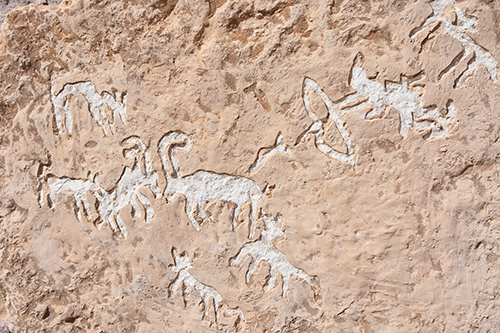 Several thousand years ago, when characters had not yet been fully developed, people engraved geometric symbols on rock walls and pottery to communicate. The symbols were drawings of what people saw - like the sun, moon, stars, mountains and rivers - and these carved imitations of things in nature would, over time, become highly representative symbols. Such primitive graphs on surfaces were actually the origin of Chinese characters. When we look at cultural relics excavated from prehistoric remains, the graphs appear quite rudimentary, much like children's drawings. People in ancient China gradually developed symbols that expressed exact meanings via graphs - and then used phonetic characters that expressed sounds, forming a sophisticated character system so that even more messages could be expressed. |
Using font design to interpret ancient characters
To build a bridge between ancient characters and modern fonts - and to create a set of ancient characters that can be recognized and used - our design team pondered how best to integrate the concept of “the antiquated” into elements of design. Our challenge was to incorporate this general concept flawlessly into a modernized font. In the beginning of the DF Bronze Inscription design process, the design team turned to the inscriptions on the Da Yu bronze vessel, on which nearly 300 characters are imprinted. These etchings are the foundations of the square - an upright, and simple style of font that is distinctive from another font previously created by DynaComware. This previously developed font - DF JinWen -was similarly inspired by bronze inscriptions, and was imbued with a style of sophistication and resplendence. To strike a balance between the recognizability of ancient and modern characters, we based our structures on historical characters derived from collections housed in first-class archive institutions - and we absorbed, internalized, and reinterpreted them as fonts that can be understood by modern people. On the other hand, we explored in depth the origin of these fonts to better preserve the intrinsic cultural value of such characters.
Ancient characters were not written on paper like modern characters are now - so the design team carefully studied the historical backgrounds of these roughly written texts, hoping to preserve and reproduce stylistic features influenced by carving tools and mediums in the DF Bronze Inscription. DF Bronze Inscription, a typeface that integrates the features of oracle bone script and bronze inscriptions, inherits the overall form and appearance of ancient characters. The strokes are rounded to better show inscriptions on bronzeware from the Shang and Zhou dynasties, such as the Da Yu bronze vessel - the broad etchings of which are particularly well-balanced and smooth, as they were originally engraved through mold casting. At the time, these etchings were standard fonts being used – and some beginning and ending strokes are somewhat sharp and pointed. This is to embody the features of oracle bone script that is carved by hand on turtle shells or animal bones using a knife, as oracle bone script was considered the iconic "handwriting font" during that particular era.
| *About the inscriptions on he Da Yu bronze vessel The Da Yu bronze vessel (cast in the 23rd year of king Kang of the Zhou period) was made 3,000 years ago - the inscriptions upon which appear to be attractive shapes that fall between graphic symbols and characters. The characters, numbering fewer than 300, are actually records of solemn religious rituals in which a nobleman named Yu was titled and rewarded by Kang of Zhou. The ding had been cast as ordered by Yu to praise this king of Zhou. Although the inscriptions on the Da Yu bronze vessel include characters of various sizes, their structure is generally upright and square, and they are deemed an iconic style of bronze inscriptions from the early Western Zhou dynasty. In general, inscriptions on bronzeware in the Shang and Zhou dynasties in China are records of temple events and political activities of noble rulers with high social status. This exemplifies the concept that "worship and war were national events of the highest gravity" during ancient China. |
DF Bronze Inscription also retains the block style in either circular or squared form, in order to better resemble the highly pictographic geometric shapes found on both bronzeware and oracle bone script. This makes the radicals even more graphical.
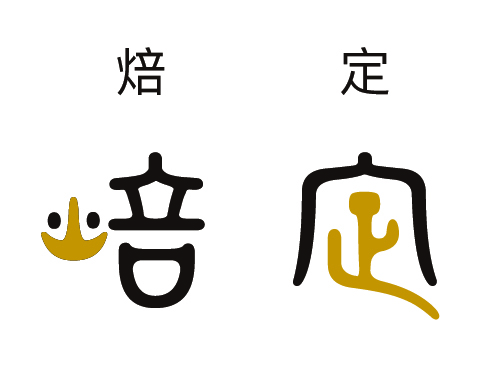
Characters that resemble emojis - expressing meaning via pictorial symbols
Ancient characters that are difficult of decipher are actually not that far removed from us. Oracle bone script and bronze inscriptions are very interesting, and the character structures in geometric shapes are almost as intuitive as today's emojis! Many animal-related characters - such as the characters for "deer," "elephant," and "tiger" - have a vivid image similar to the animals they represent. Other characters representing tableware and weapons also resemble how they looked thousands of years ago.
DF Bronze Inscription fonts still possess the amusing pictographic qualities of these ancient characters. The graphic characters that are more pictographic in nature and less easily recognizable retain the form of variant characters. In short, users can easily switch between designs as needed. Users of this font can feel the charm and culture of pictograms and communicate specific thoughts and feelings with graphic characters.
DF Bronze Inscription takes readers on a journey through history by conveying the evolution of abstruse ancient characters in an interesting way - and bringing deep cultural content to life in our current era of technological advancement. All this is accomplished while protecting and passing down the culture that lives on through this ancient font.
Giving readers a tour through history and bringing profound cultural content back to life in this technology-driven era, the DF Bronze Inscription reinvigorates ancient characters and integrates them into today's digital lifestyle.
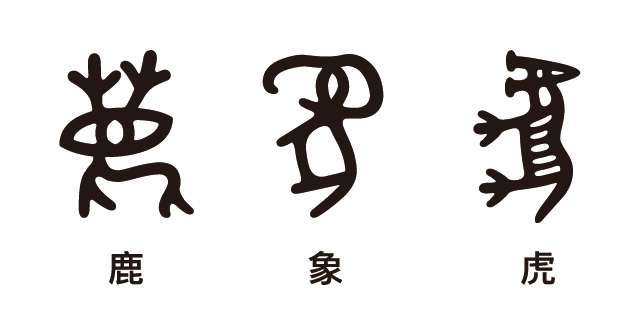 ▲The pictographic variant characters in DF Bronze Inscription are as shown from left to right: deer, elephant, and tiger.
▲The pictographic variant characters in DF Bronze Inscription are as shown from left to right: deer, elephant, and tiger. 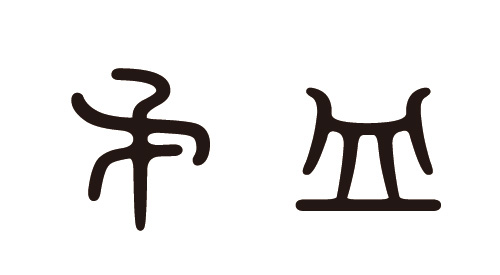 ▲Many characters in DF Bronze Inscription have interesting pictographic features. Shown on the left is the character for "spear," while the right image is the character for "dish."
▲Many characters in DF Bronze Inscription have interesting pictographic features. Shown on the left is the character for "spear," while the right image is the character for "dish."See more graphic characters in DF Bronze Inscription►
All of these interesting fonts are collected in this set of variant characters and can be easily applied to replace orthodox characters!
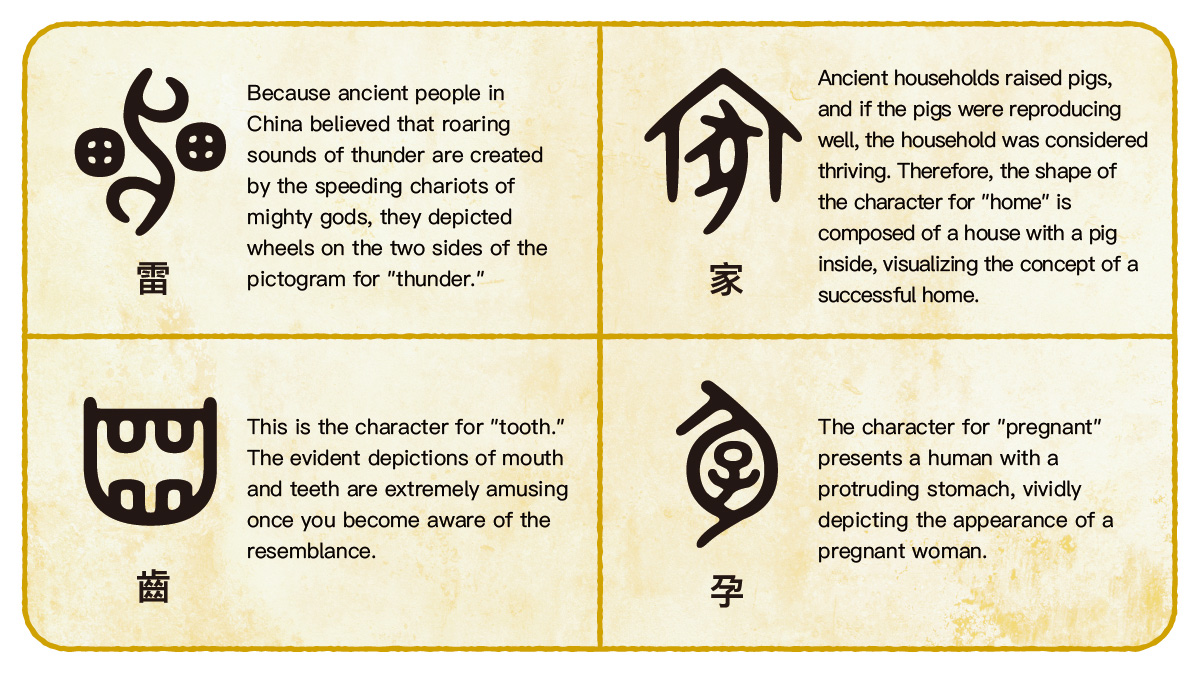
Font features of the DynaFont DF Bronze Inscription
By using the appearance of ancient characters while considering modern - day utility, 60% are immediately recognizable; 35% of them can be understood after some thought; while the remaining 5% adhere to the earliest pictograms.
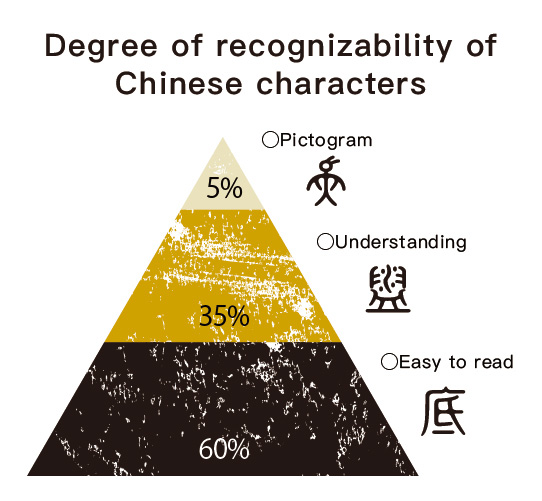
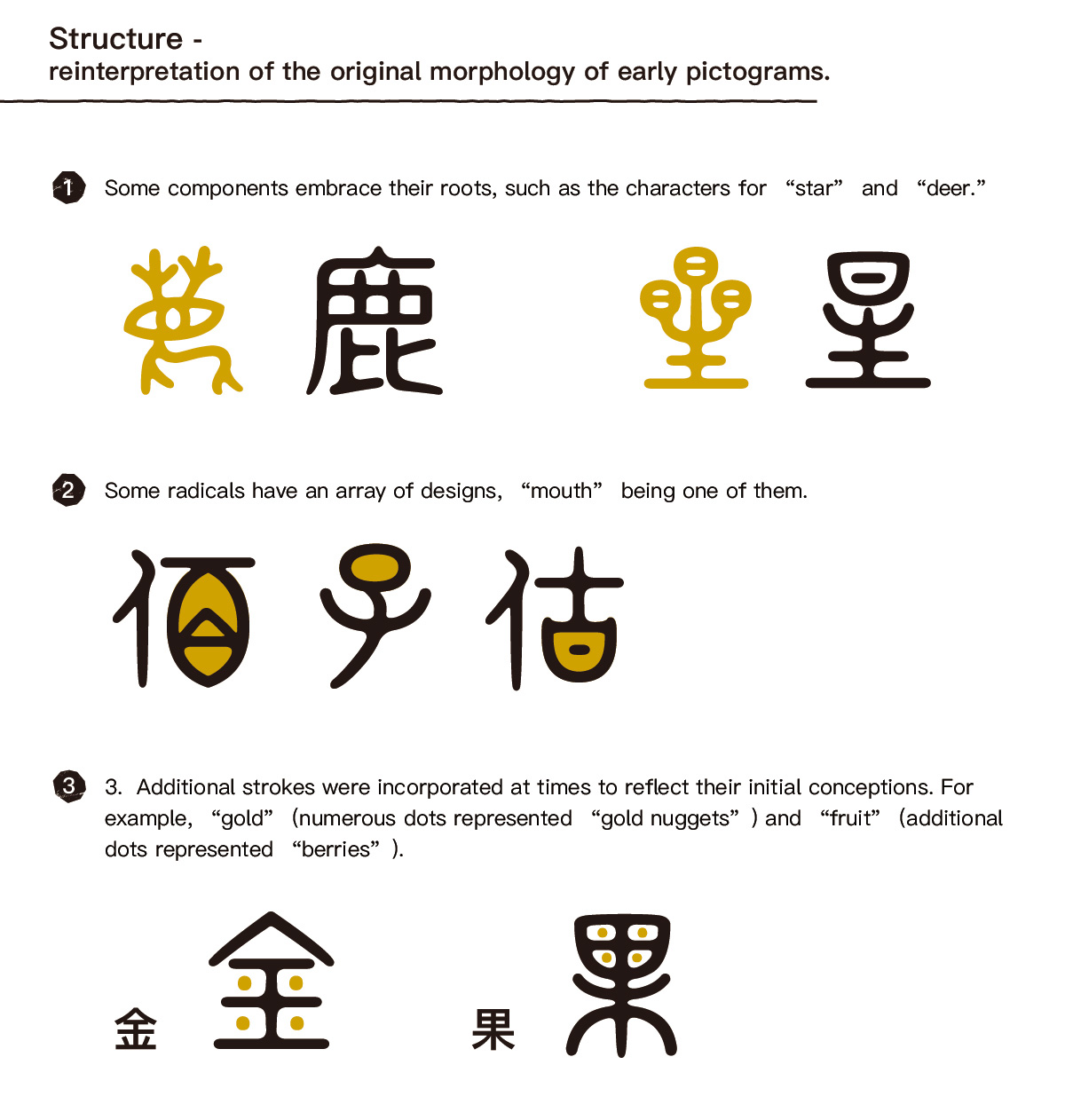
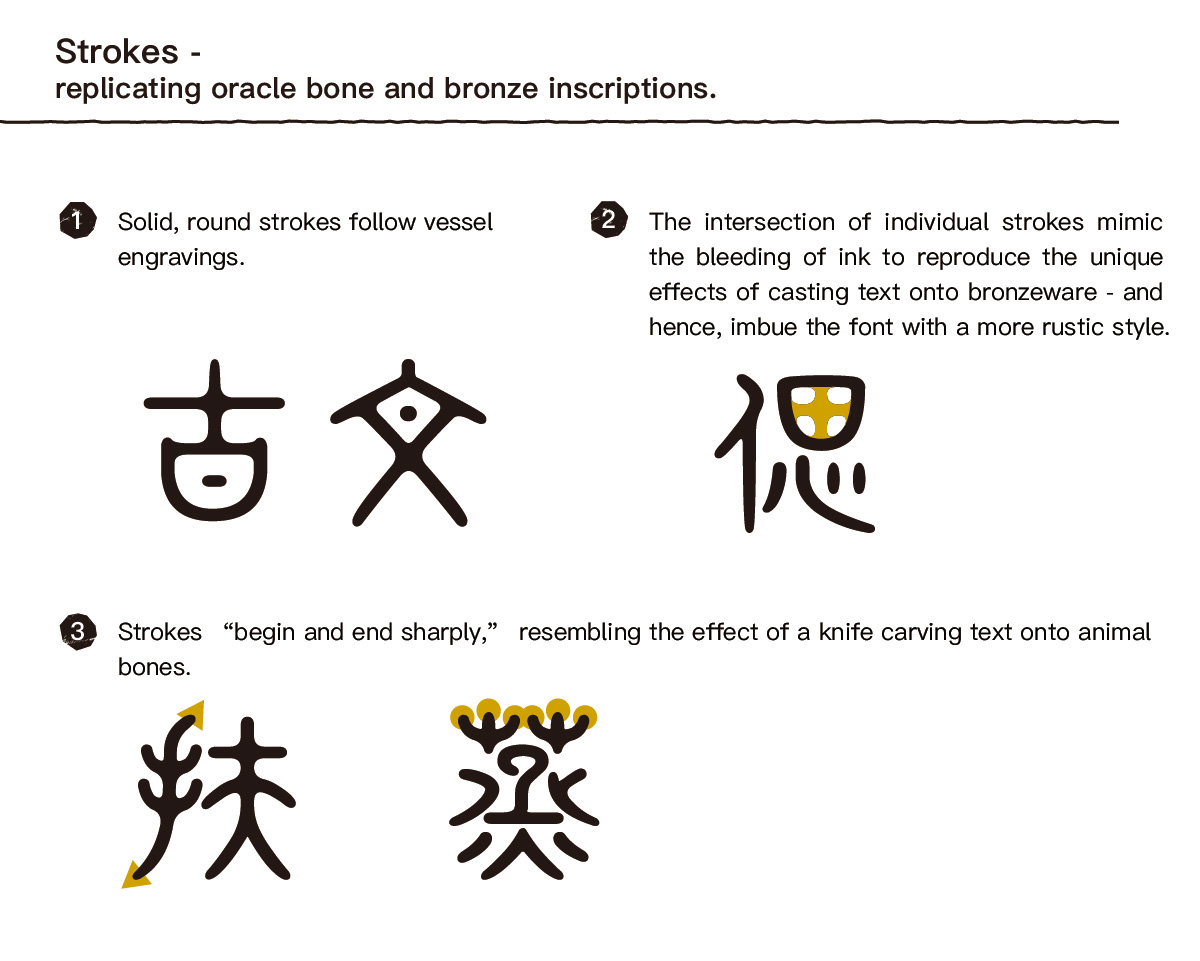
Suitable for application
DF Bronze Inscription is a font in the style of antiquated characters that can be directly applied in typesetting. The style of ancient Han characters is simultaneously extended to characters and symbols in Roman numerals and the written texts of languages such as traditional Chinese, Japanese, and English. It can be universally applied to all kinds of printing layouts and digital devices. 